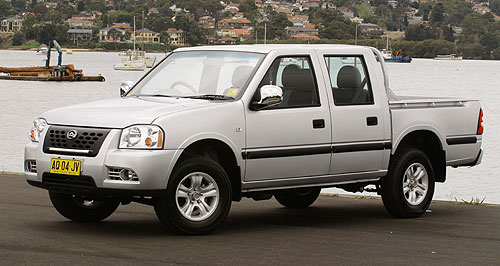News - General NewsAutomotive engineers back call for tougher ADRsStar struck: A two-star ANCAP performance for vehicles such as the Great Wall SA220 has prompted a call from engineers for stricter crash performance regulations for vehicles sold in Australia. SAE-A laments gap between ‘acceptable safety standards’ and vehicle design rules2 Oct 2009 By TERRY MARTIN THE Society of Automotive Engineers – Australasia (SAE-A) has backed the call for Australian Design Rules (ADRs) to be tightened for commercial vehicles after safety authorities raised the question this week when announcing poor crash-test results for budget-priced imported utilities. The independent Australasian New Car Assessment Program (ANCAP) handed down a damning one-star-out-of-five crash-test result on Tuesday for the Proton Jumbuck and two stars for the Great Wall Motors SA220 and V240. The results prompted ANCAP and the motoring authorities which sponsor the crash-test program to voice concern about the widening gap between ADRs – the minimum standards a vehicle must achieve to be sold in Australia – and ANCAP testing. As the representative body for automotive engineers throughout Australasia, the SAE-A has also now called for ADRs to be aligned with the engineering standards required to achieve “high crash survival outcomes”. “It appears that the ADRs are allowing the sale of vehicles which are not manufactured using the materials and engineering design technology required for structural integrity that will protect occupants at the level of four or five ANCAP stars,” said SAE-A executive director Max Chanter. “It is clear that vehicles, which may satisfy the ADRs, may not meet community expectations for safety in a crash. The SAE-A recommends the alignment of the ADRs and the engineering standards required to achieve low injury and high crash survival outcomes.”  Left: Great Wall SA220. Below: Proton Jumbuck. Left: Great Wall SA220. Below: Proton Jumbuck.As GoAuto has reported, the SAE-A raised concern about the safety of budget utilities after Great Wall Motors launched the SA220 dual-cab in June with a high level of creature comforts but without life-saving equipment such as airbags and ABS brakes. It called on the federal government to make this equipment compulsory on all vehicles sold in Australia, and urged that forthcoming legislation mandating the fitment of electronic stability control (ESC) be broadened to include light-commercial vehicles. “These are proven safety devices,” Mr Chanter said this week. “Lack of such equipment has a direct impact on the injury type and survival rate of occupants. “The SAE-A advocates that these proven vehicle-control and life-saving devices should be integrated in the ADRs. Business operators have a duty of care to employees and to other family members, who are drivers or passengers in these light-commercial vehicles. “Our community is investing heavily to increase awareness of vehicle safety and many marketers are actively promoting ANCAP scores to vehicle buyers. These investments are motivating more and more people to seek out and buy safer vehicles. “However, the Society (SAE-A) is concerned that safety is almost an afterthought in the case of some vehicle marketers. In today’s crowded market, the SAE-A does not understand why the ADRs should allow vehicles with poor structural integrity and safety equipment.” ANCAP program manager and RACV chief engineer Michael Case said this week that new vehicles which meet ADRs but still perform to a one-star or two-star standard under ANCAP were a cause for concern. “Crash statistics show that occupants of one- or two-star vehicles have twice the risk of receiving life-threatening injuries in a crash, compared with four- or five-star vehicles, at a time when four- and five-star ratings are becoming increasingly available for new-car buyers,” Mr Case said. “New vehicles that achieve only a one- or two-star ANCAP rating, while meeting the ADRs, are a cause for concern.” Great Wall Motors importer Ateco Automotive has told GoAuto that safety features such as airbags and ABS are unavailable on the SA200, and that although the V240 has them fitted standard, the latter’s two-star ANCAP result has prompted the Chinese manufacturer to reassess its crash performance. Proton Cars Australia has advised that the Malaysian-built Jumbuck will be replaced in the first half of 2010. Meanwhile, the Victorian Automobile Chamber of Commerce (VACC) this week urged motorists to be familiar with seatbelt laws and to never risk travelling without a proper restraint after a recent fatal road accident involving six teenagers in Brisbane. “Seatbelts and restraints are one of the key safety areas of a vehicle. All occupants of a vehicle should wear one, on every journey,” said VACC executive director David Purchase. “We implore all motorists to reduce risks on the road by ensuring the vehicle they are driving is well maintained and regularly serviced. In particular, we are urging drivers to ask their repairer to inspect the brakes, tyres, lights, steering and restraints – the five key safety areas of their vehicle. “This was a tragic and needless addition to the nation’s road toll. VACC asks that all motorists take vehicle safety seriously.” Victorian Transport Accident Commission (TAC) statistics show that 45 drivers and passengers killed in Victoria last year were unrestrained, and that each year around 20 per cent of car drivers and passengers killed in crashes are not wearing seatbelts. Victorian law requires that every person travelling in a car must wear a seatbelt or a child restraint if one is available. The driver must also ensure the law is observed by each passenger under 16 years. A child less than one year old must be restrained in an approved child restraint, while passengers aged between one and 15 must be held in a child restraint or seatbelt.  Read more29th of September 2009  Budget utes criticised after poor crash-test resultsProton Jumbuck scores just one star from ANCAP while Great Wall utes get two stars20th of July 2009  Re-think on compulsory ESC for LCVsAlbanese reviews decision not to include utes, vans in new ESC laws |
Click to shareGeneral News articlesResearch General News Motor industry news |
















Facebook Twitter Instagram